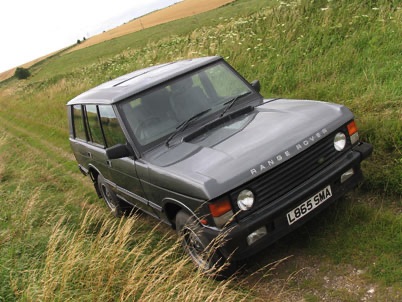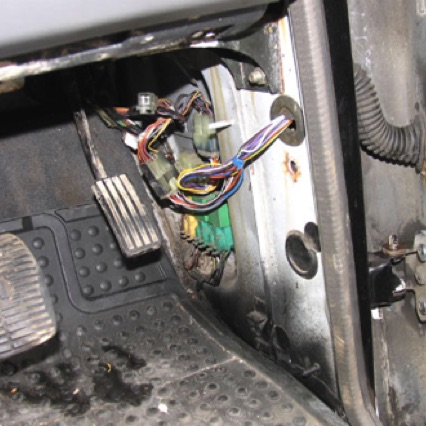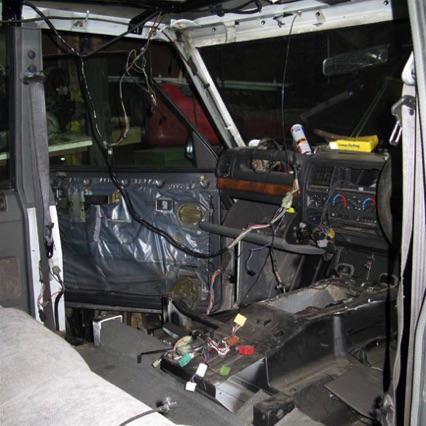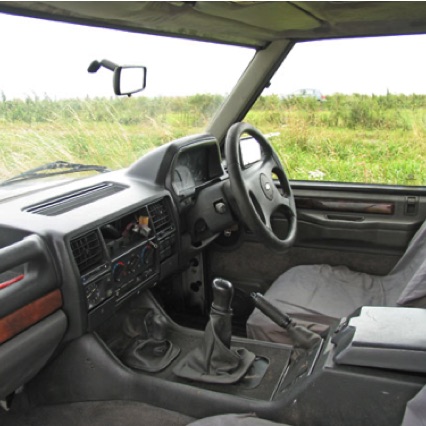
Jeremy Walton takes us through the final part of the ’12 into 1‘ Range Rover recycling saga
CLASSIC RANGE ROVER RECYCLED – Part 4
Some 22 months after the October 2006 down payment of £1,500 was made on the £4000 project to deliver a durable Range Rover 300 TDi from an ex-police 1994 hulk, we took delivery. It was not a particularly auspicious occasion, marked by a breakdown in the first 24 hours. We had a lusty vehicle of contrasting characteristics including outstanding driving dynamics, unacceptable reliability and a desperate need of final finishing.
More of that later, meantime we looked back at the 200 hours expended on the project from strip down to delivery. I asked Rob White of recycling specialists FBB, what the toughest tasks were that stuck in his memory?
“Overall, there’s no doubt the electrics gave us most grief and delayed us the longest”, ‘ he said without hesitation. Specifically the problems centered on, “using the original police loom with the addition of an electric sunroof and doors from another vehicle. We found that connectors and plugs to work with the original wiring were not the same. None of the additional luxury equipment was a straight swap as the police have different equipment requirements.” This electrical puzzle stalled the project’s completion tremendously and eventually cost us the price of a cheap Peugeot turbo diesel.
That sub-£1000 hatchback had to fill in for everyday February-July 2008 transport. We looked around for specialist electricians as Rob was snowed under with FBB’s regular customers; finally, Barry Barthorpe, engine builder and more to FBB Landrover customers, came to the rescue. “We fed Barry plenty of tea and slowly, after a lot of head scratching, he fixed it, “ recalled Rob. “Mechanically we did not have many problems that were unexpected, in fact it was all pretty straightforward on that front” reported Rob.
Earlier in the project, there was a second installation of the gearbox and clutch after: “a clip broke on the clutch slave cylinder rod.” A giant overhead gantry and chains eased the pain of lifting the Range Rover’s motor and “easing it forward a bit” so that complete removal of the motor (again) was not necessary.
It was also legally necessary to clear out the entire remaining red diesel that a previous owner had fed this RR on, requiring fresh fuel filters too. Besides fresh suspension and disc brake components, the clutch was also uprated to a heavy-duty specification, but that was (sadly) not the end of that subject.
A messy mechanical job was: “the brake lines. We fitted quite a lot of new pipe work,” remembered Rob “and that’s never a nice job.” Although the roof swap itself was as simple as shown in our picture sequences, the addition of a power sunroof caused trim and electrical complications. These were emphasized by the absence of some subsidiary soft dash interior panels and trim. Rob explained, “OK, the headlining stayed out for longer than usual while we sorted the electrics, but the additional problem was that the original headlining did not have a hole for a sunroof. We transferred one with a roof aperture, but it was not for a soft dash model and we ran into fit problems as it was a slightly different length.”
After a frustrating July week of delivery delays, my partner headed over to FBB on July 28th 2008. She waited from 3.45 pm to 7.20 as a set of appropriate Michelins were acquired and fitted on period Range Rover alloys. Some issues with the driver’s door lock were also resolved and, after a necessary fuel stop and some debate over the sticky and occasionally ineffective clutch pedal action, Deborah brought L865 SMA home.
It was obvious that there were more problems to solve, but with two temporary Peugeots now sold and one FBB loan Range Rover already consumed, we pressed the Range into local action. A run to the supermarket, £70 in then outrageously expensive diesel and shopping load on board, the reborn Range hiccupped onto the roundabout outside said supermarket and lost any pretence of clutch action. About 15 1/2 hours had elapsed since delivery! FBB attended, could not replace the failed master cylinder on the spot, so the main Shrewton FBB shop saw the project back on site. We retrieved it at the end of July with a new slave cylinder installed.
While we thrilled to Britain’s Gold medal haul at the Bejing Olympics, the Range Rover lengthened its ‘To Do’ job list, but we both enjoyed driving it. The gearbox was the slickest and lightest Rover-based 5-speed I have ever experienced. The motor was strong on mid-range torque, smoother than expected (the best TDi unit I have driven in manners, not power). A measured 33-mpg in mixed motoring was better than we had from our 200 TDi predecessor.
Those were the plus points, plus the perennial appeal of these aristocrats of the 4x4 universe for imperious travel over any surface from motorway to farm track.
The downsides were some serious recurring running problems including significant water leaks on each footwell, so that we got used to regularly emptying out protective mats. For a key we had the stub of an original item which our local sharp-eyed key cutting youth within a proper ironmongers managed to identify, so that we had two proper items several weeks after delivery. Most of the time, we could not get back in on the driver’s side, key or no key, locked or unlocked.
Another subsidiary delivery snag was a trim problem, for we only had the original gear lever gaiter and surround. I refitted it by fiddling, cursing and locating surround clips. Now we did not get dirt inside every time we went to the stables, but it would have been better to use the proper parts. It was a similar story with some items of plastic trim panels around the footwells.
As delivered, we had no covers for the electrics on either side, which meant picking your way to the throttle (see picture) with care, although I improved the situation with some racer’s tape to tuck the wiring clear of the pedal. Rob commented, “we did resolve the problem on the passenger side with a secondhand panel, but to buy new soft dash trim items, including headlining and footwells would have been too expensive for your budget.”
Minor issues included a wiper that was simply too long to be an operational rear window fit, a missing radio that boosted in-cabin noise alongside the gear lever gaiter’s original fresh-air fit. Heavily stained trim, and dirt ingrained into both front seats and the steering wheel that meant you couldn’t really use the vehicle outside missions involving overalls.
Some of these snags — like fitting a non-functional radio simply to blank of the cabin noise and give me a fairer chance of assessing the motor’s noise levels — were fixed, along with the delayed installation of a dog guard. FBB were awkward to deal with on the phone, but Rob delivered patient after-sales service.
We exceeded 500 miles and were able to exercise the engine beyond running in, and it continued to please. Unfortunately, on September 6th with less than 700 miles added, a final incident occurred. As I backed into our drive, there was a clunk from the motor department immediately accompanied by the red (electrical charge) warning light. The substantial bolt, with stud fixing for the main cam belt tensioner, sheared.
When I lifted the bonnet, the housing and ribbed drive belt lay sprawled across the front of the big 4-pot. I had switched off fast enough to save any internal damage, but I couldn’t see us relying on this vehicle again.
Currently, the Range is back at FBB, for sale at £1850.
Hindsight
Looking back at the project and the lessons learned, Rob felt: “We needed to get the vehicle out of the shop and the £4000 budget was unrealistic, so both parties suffered financially.” Rob reckoned he put about 200 hours in that would normally have cost £8000 at FBB labour rates of £40 an hour plus VAT, ignoring the recycled parts used. Rob got £4000 in stage payments and met our emergency callouts.
Our mathematics showed similar losses. We had to find £6995 for a replacement 4x4, so I traded in a 1999 BMW and lost a credit-crunched packet. Our losses currently stand at £7000, minimum.
Rob continued, “I think I would do things differently now. It’s a great driving truck, one of the best we’ve ever had, but it was spoilt by not finishing it properly. That is particularly so of the outer panels, they really needed TLC and minor spray work. That would have made it perfect, along with the right soft dash trims. It really needed another £1000 spent on it, but you only learn by a project like this.”
VERDICT: You do not need the £25,000 quoted for total classic restorations, but you must have realistic expectations of a cut price result. Or have the time and DIY skills to pitch in and get a proper reward.



